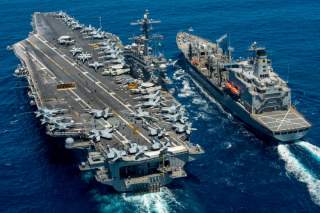Joint Operating Environment 2035 – The Joint Force in a Contested and Disordered World.
Although war endures, its character continually evolves. How this change plays out demands our attention so the United States is prepared to meet the military demands of the future.
Joint Operating Environment documents have always endeavored to describe the military implications of strategic and operational change some two decades into the future. Noting the importance of looking at the future and observing its impact on joint warfighting, General Joseph Dunford, Chairman, Joint Chiefs of Staff, noted that “the character of war today is extraordinarily dynamic.” Moreover, he asserts that the joint force must “continually adapt…and innovate to develop the capabilities we will need to win future fights.”
Recognizing this, the Joint Staff J-7 engaged in a two-year effort to better understand the characteristics of this change. One result of this ongoing effort is the recent publication of a new JOE, titled Joint Operating Environment 2035: The Joint Force in a Contested and Disordered World (JOE 2035).
JOE 2035 is a tool to collectively test our understanding of war and how it might change over the next twenty years. Moreover, it uses this understanding to assist the Joint Force to adapt to and prepare for these possible changes. Like other JOEs, it does not predict the future. But it does seek to capture important trends in the security environment. It describes how the intersection of several trends might lead to strife, conflict, and war. From this discussion, it explores implications for the structure and function of a properly-designed future Joint Force.
JOE 2035 describes a future security environment defined by twin overarching challenges. The first is contested norms. This challenge highlights the military problems associated with adversaries disputing through force the rules, agreements, customs, and standards that define today’s international order. The second is persistent disorder. This challenge is focused on adversaries exploiting the inability of societies and states to provide functioning, stable, or legitimate governance. Together, these challenges define a future security environment marked by sharp and often intense political violence, episodic warfare, and ongoing competition with a significant military dimension sort of traditional armed conflict.
Warfare in 2035 will be defined by six contexts of future conflict within these two broad challenges. They include:
- The continuation and potential acceleration of violent ideological competition with globally-ranging identity networks.
- Adversaries who can more effectively threaten U.S. territory and the freedom, safety, and autonomy of its citizens.
- The full-blown emergence of antagonistic geopolitical balancing among great powers.
- Adversaries capable of shaping, controlling, or disrupting the global commons.
- State and non-state actors engaging in a damaging contest for cyberspace.
- Shattered and reordered regions caused by civil disorder, environmental stressors, and deliberate external interference.
JOE 2035 concludes with a set of evolving missions that describes what a changing security environment might mean for the future of joint warfare. This Joint Force mission set encourages the development of a future force tailored to address a range of potential strategic goals. These goals may span from reactively managing chronic security challenges to broad and conclusive efforts to end intolerable threats to the United States and its interests.
JOE 2035 is the primary source for the problems addressed in the forthcoming Capstone Concept for Joint Operations (CCJO). Moreover, as Vice Admiral Kevin Scott, Director of the Joint Staff J-7 notes in the foreword to JOE 2035, “the ideas here should encourage a dialogue about what the Joint Force should do and be to protect the United States, its allies, its partners, and its interests around the world in 2035.” Together the new JOE and soon-to-be-published CCJO can help define and accelerate new conceptual approaches to joint warfare leading to new military advantages for the United States.
John E. DeFoor is the Futures Branch Chief, Joint Concepts Division, Joint Staff J-7.
Jeff Becker is a Futures Subject Matter Expert at Context LLC. He is currently supporting the Joint Concepts Division, Joint Staff J-7.
Image: US Navy

